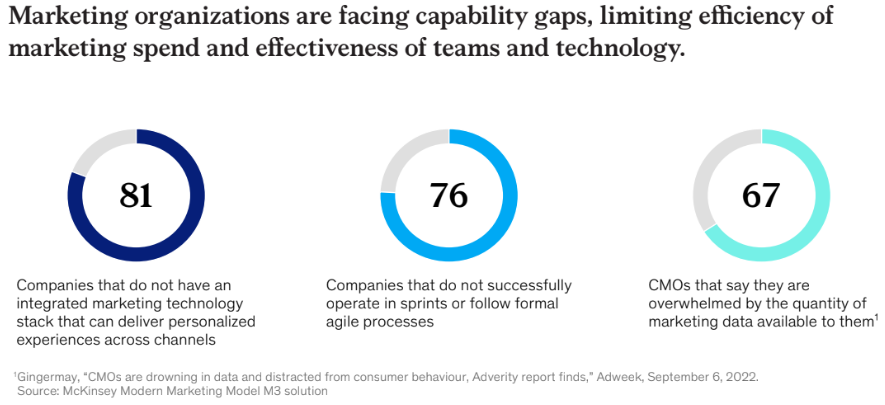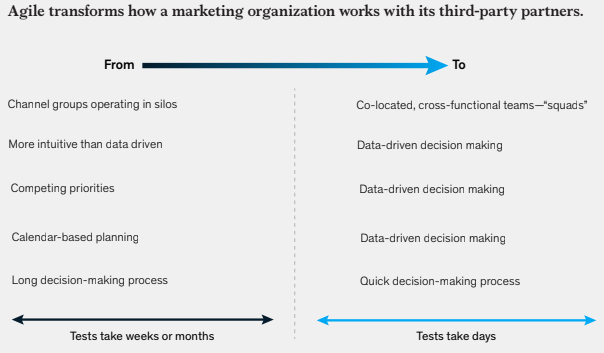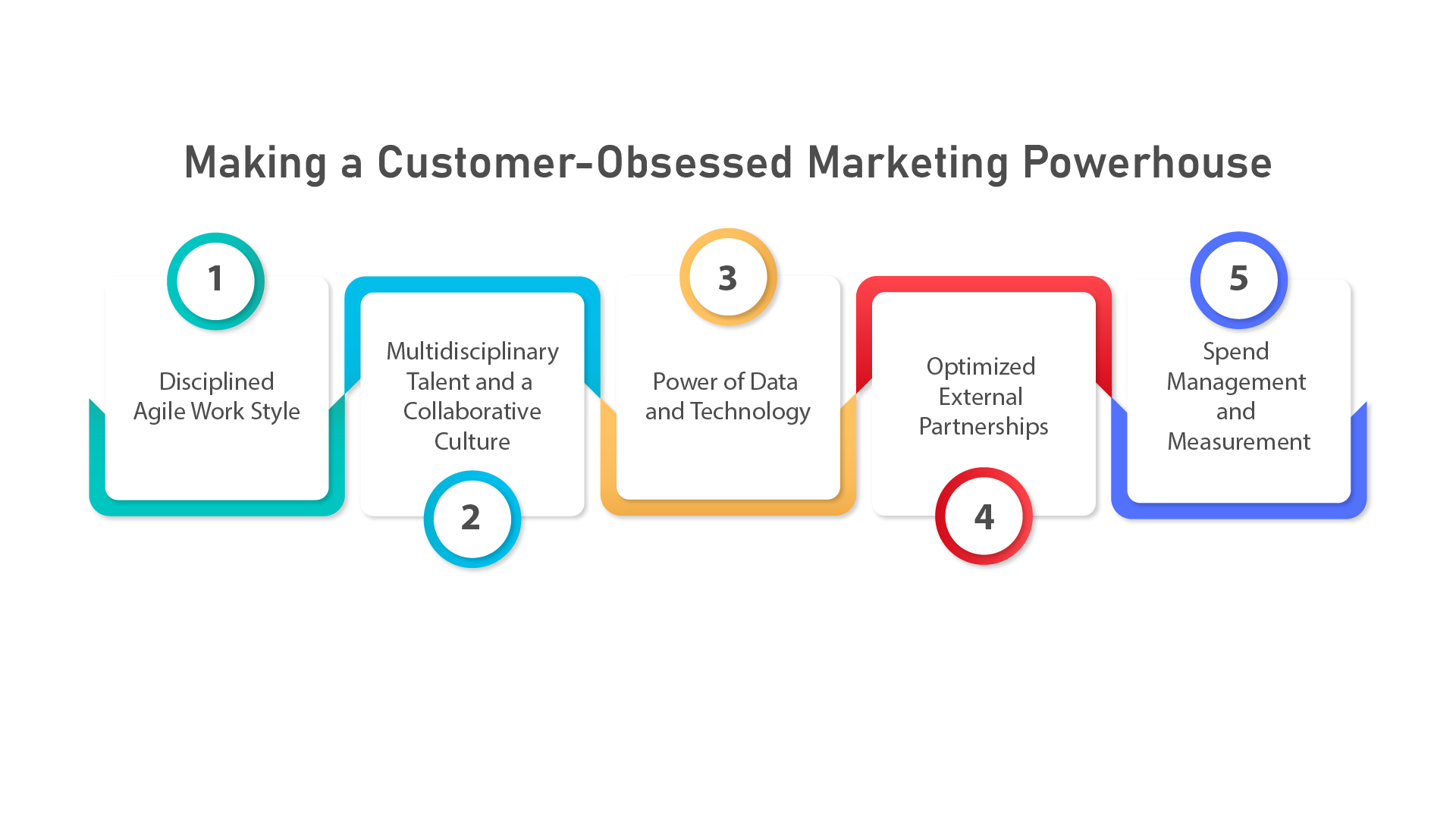We are asked a question – how you go about building organizations that don’t just keep up but actually outperform the competition. As the world around us is transforming rapidly and old methods are becoming obsolete, what are the changes that organisations should get ready to implement?
We wish to share our vision for how the best marketing teams will operate in the coming years.
Our Vision: The Agile, Customer-Obsessed Marketing Powerhouse
Picture this: a marketing organization that’s not bogged down by silos or rigid structures. Instead, it’s a dynamic network of collaborative, cross-functional teams. These teams, often working in focused “squads,” are empowered to make quick decisions. They are laser-focused on delivering results through rapid, iterative work cycles, like “sprints,” which are typically one to two weeks long.
In this utopian future, team members are versatile and adaptable. They have what we call “T-shaped” skills – deep expertise in one area combined with a broad understanding across various marketing disciplines. Alongside domain knowledge like customer insight, brand, and data analytics, they possess critical soft skills such as creativity, resourcefulness, adaptability, and collaboration.

Technology isn’t just a tool; it’s an enabler. These organizations seamlessly leverage advanced marketing technology (martech) and data analytics to gain deep customer insights. Generative AI (Gen AI) and other AI technologies power hyper-personalization at scale, allowing them to deliver the right message to the right customer at the right moment, across all channels. External partners, like agencies, are integrated as true extensions of the team, working collaboratively towards shared goals.
This vision is about customer-centricity being at the absolute core of everything, supported by agile operations, multidisciplinary talent, and cutting-edge technology to drive growth and outperform.
As we are moving in that direction, lets see the situation at present first.
The powerhouse is yet to be born
So, how close are we to this dream? Well, recent research gives us some perspective. According to Gartner’s 2019 Marketing Organization Survey, 75% of marketing leaders reported adopting agile styles of operation. This is fantastic news and shows a clear movement towards more flexible ways of working.
However, the same study found that only 7% were using formal agile methods like Scrum. This suggests that while marketers are embracing agile techniques and principles, the full, structured adoption is still relatively uncommon. This gap highlights that there’s still work to be done to fully realize the benefits of agile at scale.
What needs to be done? To answer that, lets first discuss the obstacles that need to be tackled.
Some hurdles that need to overcome first
Why aren’t more companies fully living that utopian vision yet? It’s not because they don’t want to. Marketing organizations today face incredibly complex performance expectations and rapid marketplace shifts. Trying to keep up and act quickly at scale is genuinely difficult.

Figure 2: McKinsey points out skill gaps as a major hurdle
Here as some key problems (see Figure 2 above)
- Lack of Integrated Marketing tech stack
To deliver personalised experiences to customers across channels, an integrated tech stack that keeps all the data in one place and automates actions based upon that is essential. Unfortunately, its lacking in a significant number of companies. - Skill Gaps
Marketing teams often lack critical skills in areas like customer insight, marketing technology, and data analytics. Hiring for specific skills can be siloed, leading to fragmentation and inefficiency. Marketing organizations are facing capability gaps, limiting efficiency of marketing spend and effectiveness of teams and technology - Operational Inefficiencies
Many teams are “mired by issues of weak governance, duplicate efforts, confusing processes and the under-utilization or misuse of key tools and technologies”. Investments in new tools often go underutilized because the skills to activate them are limited. - Rigid Structures
Shifting from a rigid, hierarchical structure to collaborative, cross-functional teams requires significant organizational change. Trying to flatten the organization to better align with agile is a necessary but challenging step. - Data Overload and Silos
CMOs report being overwhelmed by the quantity of marketing data. Companies often lack a holistic view of the customer because data from different channels isn’t linked. It’s difficult to derive clear, actionable recommendations from integrated data, making it feel like marketers are “trying to solve tomorrow’s problems with yesterday’s tools”. - Integrating External Partners
While external partners are valuable, integrating them into agile squads that require full dedication can be challenging for traditional agency models. There are challenges around scope of work, operating models, talent, and metrics.
These problems often stem from legacy structures, siloed ways of thinking, a lack of investment in the necessary skills and training, and the sheer difficulty of coordinating complex data, technology, and human elements across the organization and with partners.
But the problems can not be allowed to discourage enterprises today.
The Belief: As the hurdles are cleared, the marketing powerhouse is built
These problems are solvable! And if we do solve them, that utopian future we described isn’t just a pipe dream – it becomes our reality.
By directly addressing skill gaps, streamlining operations, embracing agile, becoming truly data-driven, and forging stronger partnerships, marketing organizations can unleash their full potential. Greater efficiency can free up as much as 20 percent of a marketing budget, allowing reinvestment in high-priority, growth-driving initiatives. When marketers speak the language of the C-suite, using metrics like ROI, Customer Lifetime Value (CLV), and Net Promoter Score (NPS), they build trust and gain support for strategic investments.
Ultimately, transforming how we work and equipping our teams with the right skills and tools is the key to unlocking sustained growth and outperforming the competition in a rapidly changing world.
So, what can leading marketing companies do to get there?
There are ways to clear these hurdles and move ahead
Its doable and we share some actionable steps below:
1. Embrace a Disciplined, Agile Work Style
- Develop a plan for adopting an agile marketing approach. Don’t just dabble; commit to the principles.
- Shift to a project-centric ethos focused on delivering results.
- Implement discrete iterative work cycles (sprints).
- Foster a test-and-learn culture where teams quickly learn and adapt from experiences. As one former CMO shared, successful companies “learn faster than the competition”.
- Embrace faster, decentralized decision making within agile teams.

2. Build Multidisciplinary Talent and a Collaborative Culture
- Cultivate T-shaped marketers with deep expertise and broad knowledge across disciplines like customer insight, product management, brand, content, messaging, marketing technology, data literacy, and analytics.
- Prioritize critical soft skills such as creativity, resourcefulness, adaptability, collaboration, leadership, curiosity, and resiliency.
- Make marketing capabilities a first-rate strategic priority. This isn’t an HR problem; it’s a revenue imperative.
- Invest heavily in upskilling and training across the organization, including leadership and cross-functional partners, both internal and external.
- Connect the dots across teams by training traditional marketers, performance marketers, and data scientists to understand each other’s perspectives and collaborate effectively.
- Empower individual team members to take on a range of roles aligned to project needs.
3. Leverage the Power of Data and Technology
- Empower your team with the right tools and technology that enable adaptable operations and provide visibility into project progress and resource utilization.
- Build a robust marketing technology stack.
- Establish a single source of truth for customer data, such as a Customer Data Platform (CDP).
- Utilize AI and Gen AI to drive customer insights, dynamic audience targeting, marketing optimization, personalized outreach, automated workflows, and continuous measurement.
- Focus your supporting technologies on those that enable more adaptable operations.
4. Optimize External Partnerships
- Integrate agencies as an extension of your team’s capabilities. Focus on Marketing agencies that have experience using agile principles.
- Be transparent with partners about the transition to agile and collaborate on how agency involvement will work.
- Shift from defining scope by deliverables to defining it by time, allowing for more flexibility and proactive work.
- Consider innovative compensation structures like pay-for-performance, aligning agency incentives with squad goals.
- Identify a dedicated agency lead for agile squads who can navigate the agency’s internal workings.
- Be transparent with data sharing with your agency partners. A shared view of performance data is crucial.
- Define the overall agency ecosystem vision to ensure partners fit together cohesively and eliminate overlap.
5. Master Spend Management and Measurement
- Implement rigorous tracking and active management of marketing spend.
- Know exactly what you’re spending and ensure you’re paying a fair price. Review quality and get the most out of your budget.
- Pay only for the services you really need; use flexible and iterative statements of work (SOWs).
- Tailor agency account teams to match the right people with the right projects.
- Double down on what works by getting a granular understanding of where your target consumers are and the impact of spending on them.
- Strategically bring business-critical activities in-house.
- Continuously demonstrate the value of marketing using metrics the C-suite understands, like ROI, CLV, and NPS. A retail bank CMO noted how a single source of truth from performance branding “put an end to the bickering” and allowed teams to “look at the same data basis”.

By focusing on these areas – truly embedding agile, developing versatile talent, leveraging technology and data strategically, optimizing partnerships, and mastering spend and measurement – marketing organizations can transform from simply keeping up to consistently outperforming.
What Are Your Thoughts?
Building this kind of high-performing, agile marketing organization isn’t easy. It requires fundamental shifts in how teams work, how leaders lead, and how relationships are managed. But the potential rewards – faster execution, increased productivity, higher marketing efficiency, significant growth, and deeper customer connections – are immense.
What challenges are you facing in building agility and high performance in your marketing team? What strategies have you found most effective? Share your insights in the comments below!
We have extensive experience in marketing for telecom industry in B2B settings. We offer a range of marketing and branding services, led by top professionals who have decades of experience. To know more about how we can take your organization to a higher orbit, visit Our Services Page or drop in an email to connect.
Glossary
Hyper-personalization: This refers to going beyond basic personalization to create unique messages for individual decision makers based on their needs, profile, behaviors, and interactions—both past and predictive. It involves tailoring every customer interaction to an individual’s specific requirements and preferences.
ROI: ROI, or Return on Investment, is a financial metric that measures the profitability of an investment. It’s calculated as the net income (or profit) generated from an investment divided by the cost of the investment. Essentially, it helps determine the efficiency and profitability of an investment relative to its cost.
Agile marketing approaches: This is a style of working that many marketers are adopting to adapt quickly to change, possess a wide array of skills, and deliver results. It requires changes in culture and working style, moving away from rigid structures to collaborative, cross-functional project teams. It also involves shifting from linear, hierarchical, sequential approaches to projects towards the rapid delivery of work with frequent adjustments and recalibrations
CLV : Customer Lifetime Value (CLV) represents the total net profit a business expects to generate from a customer throughout their entire relationship with the company. It’s a metric used to estimate the total revenue and income a business can anticipate from an average customer over the duration of their relationship.
NPS: NPS stands for Net Promoter Score. It’s a metric used to gauge customer loyalty and satisfaction by measuring how likely customers are to recommend a company or product to others. A single question, “How likely are you to recommend our product or service to a friend or colleague?”, is asked on a scale of 0 to 10. Responses are then categorized into Promoters (9-10), Passives (7-8), and Detractors (0-6), with the NPS score being calculated as the percentage of Promoters minus the percentage of Detractors
FAQs
1. What is a T-Shaped Marketer and why is this skill profile important for agile marketing teams?
A T-shaped marketer possesses a broad range of skills across multiple marketing areas, complemented by a significant depth of ability in a subset of those skills. This profile is essential for dynamic, agile marketing teams that need to adapt to changing requirements and support a multitude of projects. Modern marketers are already evolving from the traditional T-shape to a “Fat-T” profile, which involves having significant skill breadth and depth, plus several areas of deeper, more specialized expertise. This skill-based diversity is sought when implementing a flexible team approach, focusing on key areas of domain expertise and critical soft skills. The concept of a T-shaped skill set, with deep domain expertise and broad education across skills, is seen as the new marketing superpower, enabling better communication, creativity, quicker problem solving, and synergistic impact.
2. How is Generative AI (Gen AI) being used to transform marketing and sales?
Generative AI (Gen AI), which uses algorithms and deep-learning models to generate new content like writing, images, or audio, is disrupting marketing and sales by enabling hyper-personalization, boosting productivity, and accelerating growth. It can automate many mundane sales activities, potentially a fifth of current sales functions. Gen AI offers numerous use cases across the customer journey. At the top of the funnel, it excels at dynamic audience targeting and segmentation, lead identification, and marketing optimization through A/B testing and SEO strategies. Within the sales motion, Gen AI provides continuous support, generating personalized content and messaging, acting as a 24/7 virtual assistant, and offering real-time negotiation guidance and predictive insights. Post-sale, Gen AI can assist with customer onboarding through personalized training content and chatbots, and help sales leadership with churn modeling and dynamic customer-journey mapping. It can significantly accelerate personalized content development and amplify brand distinctiveness.
3. What is customer personalization in marketing and what makes it effective?
Customer personalization in marketing is the practice where companies use data to tailor messages to specific users’ preferences. Effective personalization delivers relevant recommendations, communicates at the right time when customers are in shopping mode, provides helpful reminders about things like restocked items, and offers a seamless experience across both offline and online interactions. To be effective without being perceived as “creepy,” brands should infuse empathy into analytics and communications, listen for feedback on customer acceptance, and test and learn constantly. Scaling personalization effectively requires a robust foundation in data and analytics, acquiring and training talent like analytics translators, building agile capabilities in cross-disciplinary teams, and protecting customer privacy. The technical blueprint for personalization involves Data, Decisioning, Design, Distribution, and Measurement. This includes managing comprehensive customer data, using advanced analytics and machine learning models to predict behavior and recommend actions, breaking content into flexible pieces, integrating channels, and measuring performance across channels.
4. How can marketing organizations improve efficiency and optimize marketing spend?
Improving marketing efficiency and spend management involves four key pillars: paying the right price, paying only for the services needed, optimizing where the work is done, and changing how the work is done. Paying the right price includes using comparable price data for negotiations, basing agency compensation on performance, and conducting frequent agency pitches. Paying only for needed services involves using flexible and iterative statements of work (SOWs), tailoring agency account teams to project needs, and analyzing data to eliminate spending on ineffective channels or audiences. Optimizing where work is done means bringing business-critical activities in-house that require deep business knowledge, speed, or offer a competitive advantage, and creating a clear ecosystem vision for external agencies. Changing how work is done includes continuously demonstrating marketing’s value to the C-suite using business metrics like ROI, CLV, and NPS, and reusing creative assets that are working. These levers, combined with a focus on rigor and transparency, provide a powerful approach to becoming a lean marketer.
5. What are the essential skills and capabilities for successful modern marketing teams?
Modern marketing success is fundamentally a skills and talent challenge. Beyond traditional domain expertise, individuals need to develop a multidisciplinary competency across six core capabilities: customer centricity, full-funnel marketing, agile operating model, multichannel excellence, measurement, and customer data and marketing technology. This leads to a “T-shaped” skill set, featuring deep expertise in one area and broad knowledge across many. The “Fat-T” profile, with significant breadth and depth plus multiple areas of specialized expertise, is increasingly important for dynamic work styles. Key marketing domain expertise includes market and customer insight, product management, and brand, content, and messaging. In addition to domain skills, critical soft skills such as creativity, resourcefulness, adaptability, collaboration, leadership, curiosity, and resiliency are vital. These soft skills act as the “glue” binding talent and are crucial for rapid feedback, iterative refinements, and adjusting to internal/external business changes. Companies need to prioritize the development of these new skills, primarily through upskilling and training, to succeed in the modern marketing landscape.
Sources
- When agile marketing breaks the agency model, article by McKinsey
- 4 Steps for Building Greater Agility in Your Marketing Organization, published by Gartner
- Modern marketing: Six capabilities for multidisciplinary teams, article published by McKinsey
- The new marketing model for growth: How CPGs can crack the code, article published by McKinsey
- The forgotten hero of marketing excellence: Spend management, article published by McKinsey
